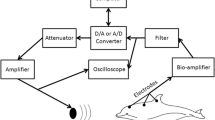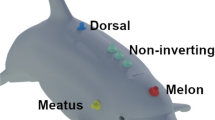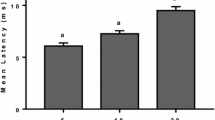Abstract
Toothed whales and dolphins (Odontocetes) are known to echolocate, producing short, broadband clicks and receiving the corresponding echoes, at extremely rapid rates. Auditory evoked potentials (AEP) and broadband click stimuli were used to determine the modulation rate transfer function (MRTF) of a neonate Risso’s dolphin, Grampus griseus, thus estimating the dolphin’s temporal resolution, and quantifying its physiological delay to sound stimuli. The Risso’s dolphin followed sound stimuli up to 1,000 Hz with a second peak response at 500 Hz. A weighted MRTF reflected that the animal followed a broad range of rates from 100 to 1,000 Hz, but beyond 1,250 Hz the animal’s hearing response was simply an onset/offset response. Similar to other mammals, the dolphin’s AEP response to a single stimulus was a series of waves. The delay of the first wave, PI, was 2.76 ms and the duration of the multi-peaked response was 4.13 ms. The MRTF was similar in shape to other marine mammals except that the response delay was among the fastest measured. Results predicted that the Risso’s dolphin should have the ability to follow clicks and echoes while foraging at close range.








Similar content being viewed by others
Abbreviations
- ABR:
-
Auditory brainstem response
- AEP:
-
Auditory evoked potential
- DAQ:
-
Data acquisition
- EEG:
-
Electroencephalogram
- EFR:
-
Envelope following response
- FFT:
-
Fast Fourier transform
- ICI:
-
Inter click interval
- MRTF:
-
Modulation rate transfer function
- RFR:
-
Rate following response
- SAM:
-
Sinusoidal amplitude modulated
- SPL:
-
Sound pressure level
References
Au WWL (1993) The sonar of dolphins. Springer, Berlin Heidelberg New York
Dolphin WF, Mountain DC (1993) The envelope following response (EFR) in the Mongolian gerbil to sinusoidally amplitude-modulated signals in the presence of pure gated tones. J Acous Soc Am 94:3215–3226
Dolphin WF, Au WWL, Nachtigall PE, Pawloski JL (1995) Modulation rate transfer functions to low frequency carriers by three species of cetaceans. J Comp Phys A 177:235–245
Farley G, Starr A (1983) Middle and long latency auditory evoked potentials in cat. I. Component definition and dependence on behavioral factors. Hear Res 10:117–138
Hecox K, Galambos R (1974) Brain stem auditory evoked responses in human infants and adults. Arch Oto 99:30–33
Herzing DL (1996) Vocalizations and associated underwater behavior of free-ranging Atlantic spotted dolphins, Stenella frontalis, and bottlenose dolphins,Tursiops truncatus. Aqua Mam 22:61–79
Johnson MP, Madsen PT, Zimmer WMX, Aguilar de Soto N, Tyack PL (2004) Beaked whales echolocate on prey. Proc Roy Soc Lond B 271 (Suppl 6):S383–S386
Ketten DR (2000) Cetacean ears. In: Au WWL, Popper AN, Fay RJ (eds) Hearing by whales and dolphins. Springer, Berlin Heidelberg New York, pp 43–108
Kuwada S, Batra R, Maher VL (1986) Scalp potentials of normal and hearing-impaired subjects in response to sinusoidally amplitude-modulated tones. Hear Res 21:179–192
Kuwada S, Anderson JS, Batra R, Fitzpatrick DC, Teissier N, D’Angelo WR (2002) Sources of the scalp-recorded amplitude modulated following response. J Am Acad Aud 13:188–204
Lammers MO, Au WWL, Aubauer R, Nachtigall PE (2004) A comparative analysis of the pulsed emissions of free-ranging Hawaiian spinner dolphins (Stenella longirostris). In: Thomas JA, Moss CF, Vater M (eds) Echolocation in bats and dolphins. The University of Chicago Press, Chicago and London, pp 414–419
Madsen PT, Johnson M, Aguilar de Soto N, Zimmer WMX, Tyack PL (2004a) Biosonar performance of foraging beaked whales (Mesoplodon densirostris). J Exp Bio 208:181–194
Madsen PT, Kerr I, Payne R (2004b) Echolocation clicks of two free-ranging, oceanic delphinids with different food preferences: false killer whales Pseudorca crassidens and Risso’s dolphins Grampus griseus. J Exp Bio 207:1811–1823
Mohl B, Au WWL, Pawloski JL, Nachtigall PE (1999) Dolphin hearing: relative sensitivity as a function of point of application of a contact sound source in the jaw and head region. J Acous Soc Am 105:3421–3424
Nachtigall PE, Au WWL, Pawloski JL, Moore PWB (1996) Risso’s dolphin hearing thresholds in Kaneohe Bay, Hawaii. In: Kastelein RA, Thomas JA, Nachtigall PE (eds) Sensory systems of aquatic mammals. DeSpil, The Netherlands, pp 49–55
Nachtigall PE, Lemonds DW, Roitblat HL (2000) Psychoacoustic studies of dolphin and whale hearing. In: Au WWL, Popper AN, Fay RJ (eds) Hearing by whales and dolphins. Springer, Berlin Heidelberg New York, pp 330–363
Nachtigall PE, Yuen MM, Mooney TA, Taylor K (2005) Hearing measurements from a stranded infant Risso’s dolphin, Grampus griseus. J Exp Biol 208:4181–4188
Norris KS (1968) The evolution of acoustic mechanisms in odontocete cetaceans. In: Drake ET (ed) Evolution and environment. Yale University Press, New York, pp 297–324
Penner RH (1988) Attention and detection in dolphin echolocation. In: Nachtigall PE, Moore PWB (eds) Animal sonar process and performance. Plenum Press, New York and London, pp 707–713
Philips JD, Nachtigall PE, Au WWL, Pawloski JL, Roitblat HL (2003) Echolocation in the Risso’s dolphin, Grampus griseus. J Acous Soc Am 113:605–616
Popov VV, Supin AY (1990) Electrophyiological studies of hearing in some cetaceans and a manatee. In: Thomas JA, Kastelein RA (eds) Sensory abilities of cetaceans. Plenum Press, New York, pp 405–415
Rees A, Green GGR, Kay RH (1986) Steady-state evoked responses to sinusoidally amplitude-modulated sounds recorded in man. Hear Res 23:123–133
Rice DW (1998) Marine mammals of the world: systematics and distribution. Society for Marine Mammalogy, Lawrence, Kansas
Supin AY, Popov VV (1995) Envelope-following response and modulation rate transfer function in the dolphin’s auditory system. Hear Res 92:38–45
Supin AY, Popov VV, Mass AM (2001) The sensory physiology of aquatic mammals. Kluwer, Dordrecht
Szymanski MD, Supin AY, Bain D, E., Henry KR (1998) Killer whale (Orcinus orca) auditory evoked potentials to rhythmic clicks. Mar Mam Sci 14:676–691
Yost WA (1994) Fundamentals of hearing: an introduction. Academic, San Diego
Zimmer WMX, Tyack PL, Johnson MP, Madsen PT (2005) Three-dimensional beam pattern of regular sperm whale clicks confirms bent-horn hypothesis. J Acous Soc Am 117:1473–1485
Acknowledgements
The authors are in grateful appreciation to Pedro Lavia and Elio Vicente of ZooMarine Portugal, acknowledging that none of the data would have been collected without their generosity and scientific interest. Also, the authors thank Alexander Ya. Supin for invaluable continual advice, Darlene R. Ketten for referring the task, Trevor Spradlin and Roger Gentry for advice about permits, and Whitlow Au and our colleagues at the Marine Mammal Research Program of the University of Hawaii. Two anonymous reviewers provided valuable advice on the manuscript. This study was supported by the Office of Naval Research grant N00014-98-1-0687, for which the authors thank Mardi Hastings and Robert Gisiner. This is contribution number 1213 from the Hawaii Institute of Marine Biology.
Author information
Authors and Affiliations
Corresponding author
Rights and permissions
About this article
Cite this article
Mooney, T.A., Nachtigall, P.E. & Yuen, M.M.L. Temporal resolution of the Risso’s dolphin, Grampus griseus, auditory system. J Comp Physiol A 192, 373–380 (2006). https://doi.org/10.1007/s00359-005-0075-4
Received:
Revised:
Accepted:
Published:
Issue Date:
DOI: https://doi.org/10.1007/s00359-005-0075-4




